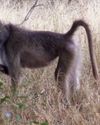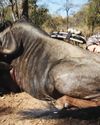The chacma baboon is one of Africa’s most intelligent and entertaining mammals. The name “chacma” is derived from the Khoi name for baboon – choachamma or choa kamma. They have a well-ordered and well-developed social order with a wide variety of social behaviours, including a dominance hierarchy, collective foraging, adoption of young by females and friendship pairings. They are widespread throughout South Africa.

Because they are always on the lookout for potential dangers and predators they are difficult to hunt. Sentries posted on high ground or tall trees will be quick to sound the alarm at the approach of any perceived danger. The real challenge to a bowhunter will be to stalk up close enough for a shot or induce a baboon to approach close enough to offer a shot from a concealed position.
DESCRIPTION
Chacma baboons are large primates with a dog-like face, prominent muzzle and long canines, which may be as long as 5 cm. A mature male measures 1.5 metres from head to tail and weighs on average 33 kg, but can weigh as much as 45 kg. Females are smaller. The fur is coarse, the colour may be grey to nearly black with grey-brown being the most common. There is a patch of rough hair on the nape of the neck. The tail is long (up to 84 cm in length) and is held in a characteristic arch. Males have a pad of naked hard grey skin on the buttocks. The female’s buttockpads are pink in colour and become bright and swollen when they are on heat. Baboon have long limbs – the front being longer than the hind – and have hands and feet with long, dexterous fingers. Baboon are active during the day, spending most of the time foraging. They sleep in trees, cliffs or where they are safe from predators at night.
BIOLOGY
Preferred habitat
Chacma baboon are widely distributed in South Africa and occupy a wide range of habitats including savannah, woodland, steppes, sub-desert (Kalahari), grassy alpine slopes of the Drakensberg, Cape Fynbos and succulent Karoo. They require large trees or cliffs in which to take shelter at night and are water dependent. The availability of water can determine their range.
Behaviour and habits
This story is from the August 2016 edition of Africa's Bowhunter.
Start your 7-day Magzter GOLD free trial to access thousands of curated premium stories, and 8,500+ magazines and newspapers.
Already a subscriber ? Sign In
This story is from the August 2016 edition of Africa's Bowhunter.
Start your 7-day Magzter GOLD free trial to access thousands of curated premium stories, and 8,500+ magazines and newspapers.
Already a subscriber? Sign In

Bowhunting Chacma Baboon
The chacma baboon is one of Africa’s most intelligent and entertaining mammals. The name “chacma” is derived from the Khoi name for baboon – choachamma or choa kamma. They have a well-ordered and well-developed social order with a wide variety of social behaviours, including a dominance hierarchy, collective foraging, adoption of young by females and friendship pairings. They are widespread throughout South Africa.

My First Bowhunt
Sean is a commercial photographer,prolific Instagrammer and serial Facebooker. He is also a Staff Shooter for Bowtech SA, GoldTip, Beestinger,Sureloc& Team AZU and is the media liaison person for the South African National Archery Association (SANAA).

Hunting Out Of A Pop-Up Blind
I only got the chance to hunt out of a pop-up blind on one of my recent hunts and I was amazed at the results! We had had the Gorilla pop-up blind for a few years, but I never really got the opportunity to use it.

Hard Work Makes Dreams Come True!
Here we are, five years down the line. I can honestly say it has been and still is an awesome, scary and exhilarating journey!

When Not To Shoot
Don’t shoot if you are not sure of the sex of the animal.